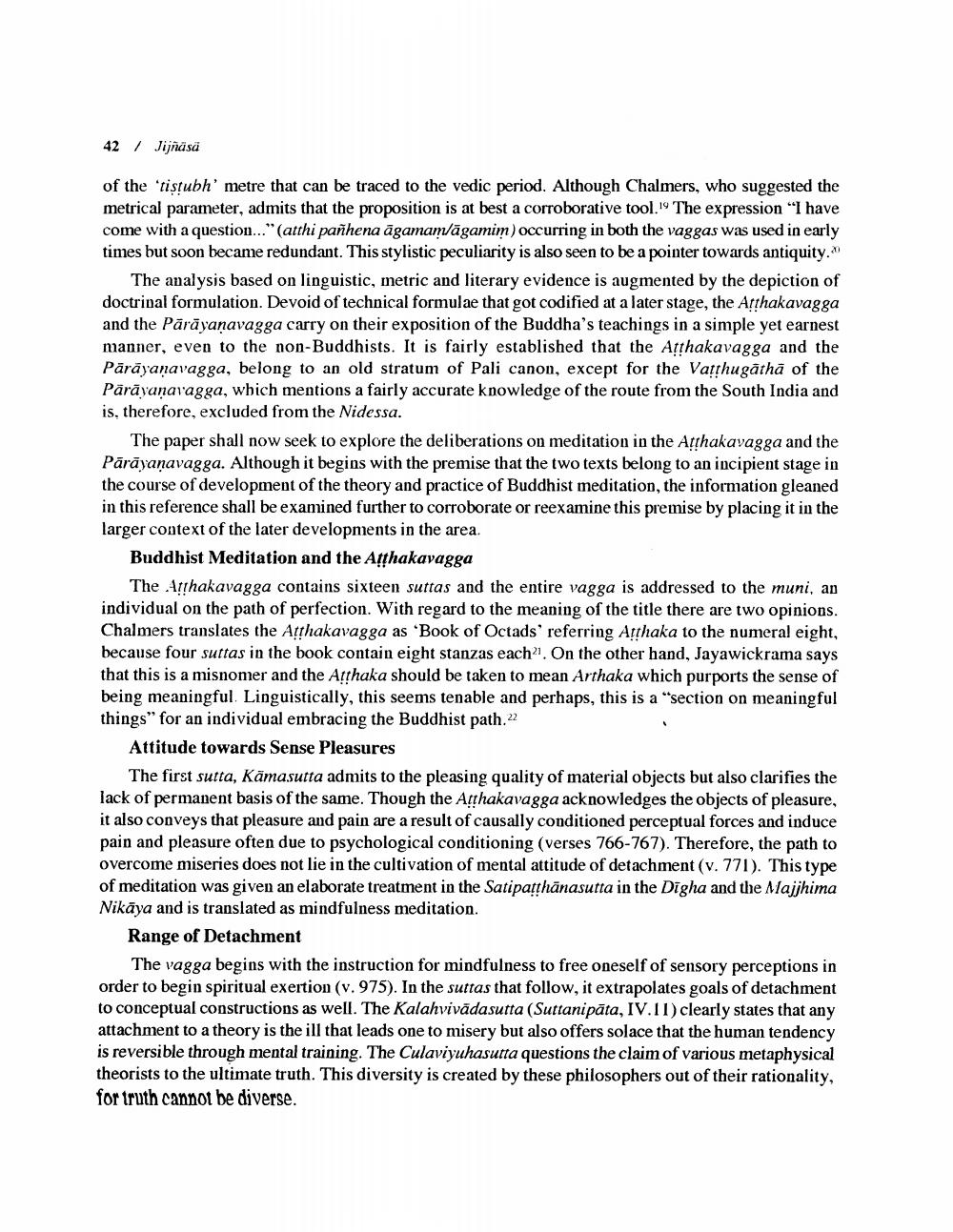________________
42
/ Jijñasa
of the 'tistubh' metre that can be traced to the vedic period. Although Chalmers, who suggested the metrical parameter, admits that the proposition is at best a corroborative tool.19 The expression "I have come with a question..." (atthi panhena āgamam/āgamim) occurring in both the vaggas was used in early times but soon became redundant. This stylistic peculiarity is also seen to be a pointer towards antiquity.
The analysis based on linguistic, metric and literary evidence is augmented by the depiction of doctrinal formulation. Devoid of technical formulae that got codified at a later stage, the Atthakavagga and the Pārāyaṇavagga carry on their exposition of the Buddha's teachings in a simple yet earnest manner, even to the non-Buddhists. It is fairly established that the Atthakavagga and the Pārāyaṇavagga, belong to an old stratum of Pali canon, except for the Vathugāthā of the Pārāvanavagga, which mentions a fairly accurate knowledge of the route from the South India and is, therefore, excluded from the Nidessa.
The paper shall now seek to explore the deliberations on meditation in the Athakavagga and the Pārāyaṇavagga. Although it begins with the premise that the two texts belong to an incipient stage in the course of development of the theory and practice of Buddhist meditation, the information gleaned in this reference shall be examined further to corroborate or reexamine this premise by placing it in the larger context of the later developments in the area.
Buddhist Meditation and the Atthakavagga
The Atthakavagga contains sixteen suttas and the entire vagga is addressed to the muni, an individual on the path of perfection. With regard to the meaning of the title there are two opinions. Chalmers translates the Atthakavagga as Book of Octads' referring Arthaka to the numeral eight, because four suttas in the book contain eight stanzas each. On the other hand, Jayawickrama says that this is a misnomer and the Athaka should be taken to mean Arthaka which purports the sense of being meaningful. Linguistically, this seems tenable and perhaps, this is a “section on meaningful things" for an individual embracing the Buddhist path.22
Attitude towards Sense Pleasures
The first sutta, Kamasutta admits to the pleasing quality of material objects but also clarifies the lack of permanent basis of the same. Though the Atthakavagga acknowledges the objects of pleasure, it also conveys that pleasure and pain are a result of causally conditioned perceptual forces and induce pain and pleasure often due to psychological conditioning (verses 766-767). Therefore, the path to overcome miseries does not lie in the cultivation of mental attitude of detachment (v. 771). This type of meditation was given an elaborate treatment in the Satipatthānasutta in the Digha and the Majjhima Nikāya and is translated as mindfulness meditation.
Range of Detachment
The vagga begins with the instruction for mindfulness to free oneself of sensory perceptions in order to begin spiritual exertion (v.975). In the suttas that follow, it extrapolates goals of detachment to conceptual constructions as well. The Kalahvivādasutta (Suttani pāta, IV.II) clearly states that any attachment to a theory is the ill that leads one to misery but also offers solace that the human tendency is reversible through mental training. The Culaviyuhasutta questions the claim of various metaphysical theorists to the ultimate truth. This diversity is created by these philosophers out of their rationality, for truth cannot be diverse.




